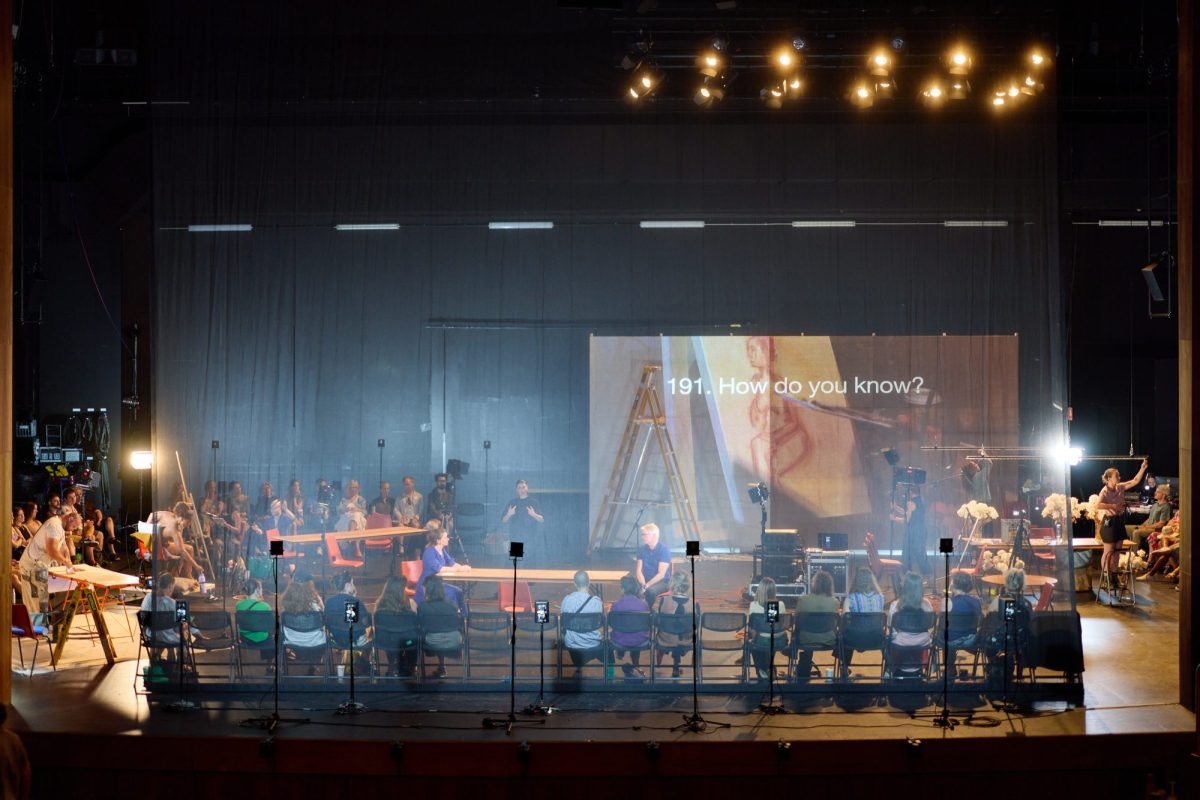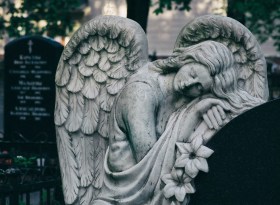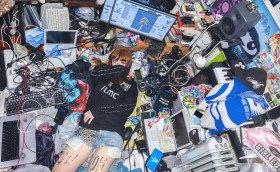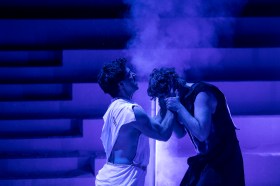UK director Richard Gregory’s 12 Last Songs (created with his company Quarantine) featured 30 paid ‘workers’ – people from the local community – who came and went in overlapping shifts and answered a series of 600 scripted questions (which they didn’t know in advance, and didn’t have to answer) about what they do for a living (among other things); some also offered demonstrations of their work.
The questions were asked by a company member, Leentje van de Cruys, and two local Perth ‘performers’, Adriano Cappelletta and Sisonke Msimang, also ‘working’ in shifts. There was also a company video artist, Lowri Evans, who also came and went throughout the day, but was mostly roaming the city and sending live video footage back to the show, where it was projected on a large screen. Then there were two local Auslan interpreters (who also worked in alternating shifts), and an ensemble of company creatives and technical crew as well as local venue techs.
The show started at midday and continued for 12 hours until midnight, with visitors encouraged to come and go as they pleased, depending on venue capacity. There was only one performance in Perth; this was the eighth performance (and city) since the show premiered in Leeds in 2021.
We were invited to sit either in the auditorium or onstage, where a single row of chairs was arranged in a huge square. Inside the square there were more chairs, as well as tables, microphones and floodlights on stands attached to a sprawling tangle of leads, all scattered around the space. There were also two screens, a huge one upstage and a smaller one in a downstage corner of the square.
There was a sense of a communal event. None of us quite knew what we were in for; to some extent this was also true for the ‘workers’ and ‘performers’, and even for the creatives and crew.
The first ‘worker’ to be interviewed was one of the sound crew, who was already at work setting up for the show. He answered a few questions about what he does, and then about what still needed to be done before the show could begin.
One of Richard Strauss’s Four Last Songs played briefly and was cut off by a dance track. The show began.
The first ‘guest worker’ was Derek, a Whadjuk Noongar actor who’s also an eco-education officer. He briefly explained what this entails before moving on to one of his other jobs, which was to perform a Welcome To Country for the show (he also brought his didgeridoo along).
Over the next few hours we met Dan, a painter and decorator, who also answered questions before pasting successive layers of wallpaper onto the screens with images of clouds (and later, stars); Patient, a hair-braider, and her cousin and client, Youngor, who then had her hair braided onstage during the interviews that followed. These included Mark, a baker and pastry chef, who shared his baked goods with us; Wendy, a postie; Peter, a martial arts instructor (who then brought on some of his teenage students for a demonstration class, at the end of which they were given a surprise graduation ceremony and received their next-level karate belts; Pauline, a midwife, who offered a lecture-demonstration about birthing, using a table, a doll-baby and a plastic pelvis; Helen, a dog-groomer, who brought a dog onstage and groomed it throughout the next few interviews; and Bec, a florist, who told us about working on Valentine’s Day, before setting to work hanging a complex arrangement of 300 flowers for a forthcoming wedding.
It was now mid-afternoon. I decided to leave and returned a few hours later to find the stage subtly transformed (Dan had been hard at work with the wallpaper; the flower arrangement had gone) and a mostly different audience. I sat in the auditorium and listened to Alana, a former politician; Faisal, an imam; Nat, a local councillor and queer/trans/disability activist; and John, a real estate agent (whose real passion is dressage).
The questions became less comfortable, and the answers more prickly, especially around ethics and politics, race and religion, status and class, money and power. The distinction between ‘worker’ and ‘performer’ was becoming more blurred. ‘Performers’ weren’t the only people whose jobs also involved a level of ‘performance’.
They were joined by Mitch and Tyler, event coordinators in matching blue T-shirts labelled ‘Perth Bouncy Castle Hire’ who proceeded to answer questions while inflating an enormous bouncy castle that Faisal, Nat and John climbed up and slid down before leaving (along with Alana). After they’d gone, Mitch and Tyler packed up the bouncy castle while answering more questions – some of which were also more challenging (‘How did you vote in the Voice Referendum?’).
There was another ‘shift’, and we met Ruby, a sex worker and pole-dancer (who also gave us a demonstration); Paul, an anaesthetist (who didn’t); and Innocent, a taxi-driver for whom family is everything. The questions felt more intimate now, and the questioning more delicate.
Dan finished his wallpapering (he’d been going for nearly 10 hours) and sat alongside one of the Auslan interpreters, Elliot, who had also finished their final shift. They answered a series of questions that become more existential and even cosmological before leaving the stage. It was time to meet David, an experimental physicist and astrophysicist, who demonstrated his work in the form of a lecture on the history of astronomy and our understanding of the universe.
We’d reached the final hour of the show, the last hour before midnight, and there was a sense of endings, personal and cosmic. Lowri returned and gave us a final round-up of the 12 last things she’d seen and captured on video while wandering Perth: the sun setting into the Indian Ocean, happy crowds leaving Perth Stadium after a Kylie concert. The sound technician was interviewed again about what needed to happen before he could finish his work and leave the venue. This reviewer felt he was being told what will happen when I die.
Finally the stage was silent and empty except for two venue techs slowly constructing a miniature stage and backdrop decorated with fairy lights. The wallpaper on the upstage screen had images of galaxies, over which passed pinpricks of light from a mirror ball slowly turning. Seated with us in the auditorium, the three ‘performers’ began to recite the entire list of 600 questions from the past 12 hours. They resonated unanswered as we asked them silently of ourselves.
A final ‘worker’ was summoned. A retired singer. She stood on the miniature stage, answered another series of questions, and then was asked a final question: ‘What song would you choose to end the show?’ And then she sang.
Read: Theatre Review: Cruise, KXT on Broadway, Mardi Gras
It’s hard to describe the cumulative and transformative effect of 12 Last Songs. Concept and dramaturgy offered a cornucopia of ideas about work and performance, the dignity of labour, and what it means to ‘be’ something or someone. The ‘workers’ and ‘performers’ gave generously of themselves and, unlike an interrogation (see Is This A Room), the questions here were open-ended. The questioners were genuinely curious; those who were questioned didn’t have to answer them if they didn’t want to; and sometimes they didn’t.
Some questions are unanswerable.
12 Last Songs
Heath Ledger Theatre, WA State Theatre Centre
Created and Director: Richard Gregory
Designer: Simon Banham
Lighting Designer: Mike Brookes
Collaborating Artist and Assistant Director: Sarah Hunter
Questions text: Sarah Hunter, Leentje Van de Cruys
Video Artist: Lowri Evans
Dramaturgy: Renny O’Shea, Sarah Hunter, Leentje Van de Cruys
Production Manager: Matt Webster
Producer: Kevin Jamieson
12 Last Songs was performed on 15 February 2025 as part of Perth Festival.






